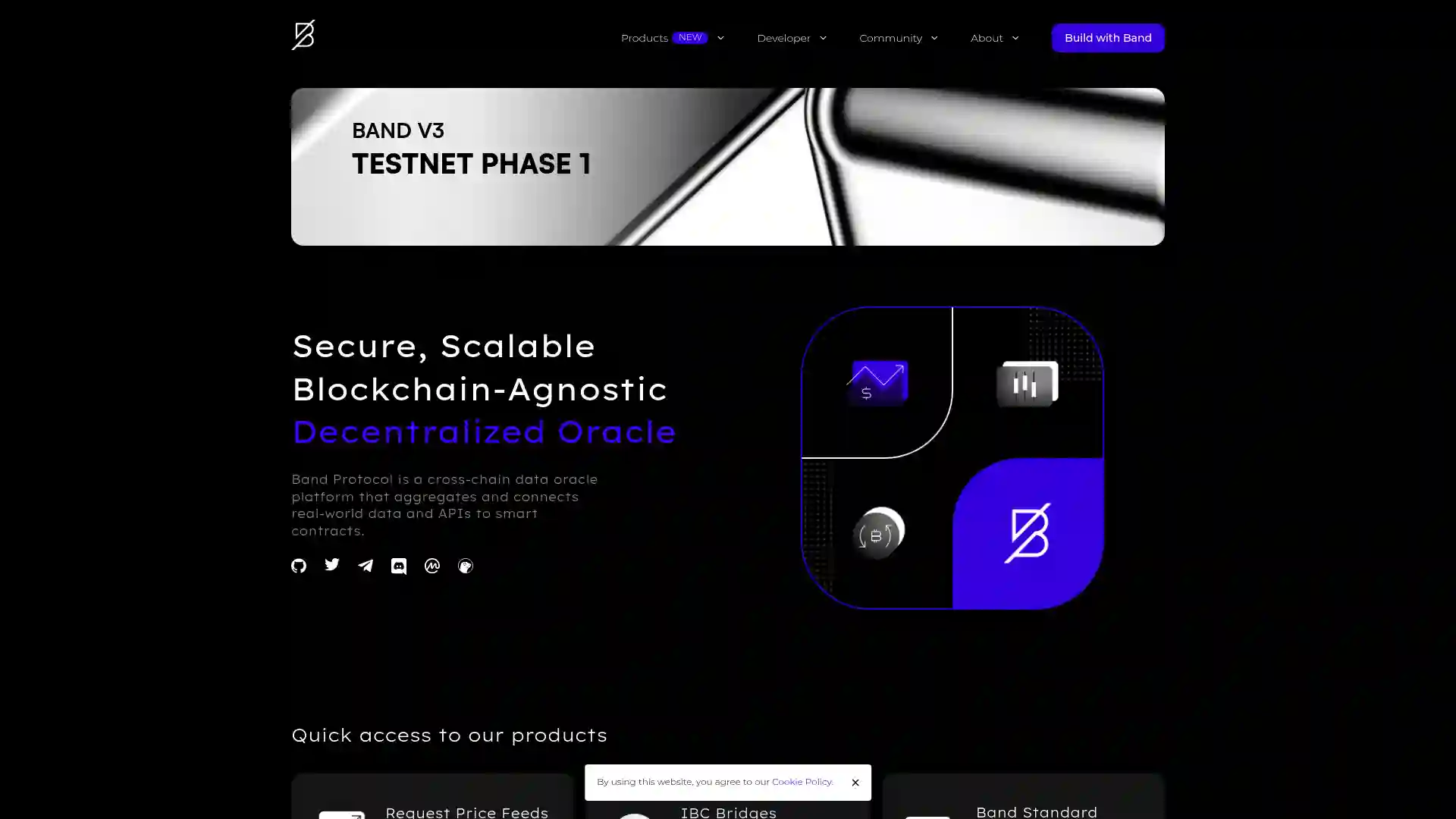Band Protocol (BAND)
Band Protocol is a decentralized data oracle that provides a reliable method for on-chain data queries using Delegated Proof of Stake (dPoS) to maintain data integrity. It is designed to serve as a primary data infrastructure layer for Web 3.0 applications, delivering decentralized, curated off-chain data to smart contracts through oracles managed by its dPoS consensus mechanism.
Overview
Band Protocol operates as a cross-chain data oracle platform, connecting real-world data and APIs to smart contracts. It facilitates the development of smart contract applications, such as DeFi, prediction markets, and games, without dependency on centralized oracles. The protocol is supported by notable stakeholders, including Sequoia Capital and Binance, a leading cryptocurrency exchange.
BAND token

| Ticker | BAND |
| Category | Business Services |
| Website | https://bandprotocol.com/ |
| @bandprotocol | |
| Telegram | bandprotocol |
| https://www.reddit.com/r/bandprotocol | |
| Contract Addresses | |
|---|---|
| ethereum | 0xba...55 Copied! Copied! |
| fantom | 0x46...c5 Copied! Copied! |
| energi | 0xb2...64 Copied! Copied! |
The BAND token was initially released through an initial exchange offering (IEO) on the Binance Launchpad in September 2019. During this process, 27.37% of the total supply was sold across seed, private, and public sale rounds. The token supply is capped at 100 million, with just over 20 million tokens in circulation as of November 2020. The allocation includes 20% for the team, 5% for advisors, and 25.63% for the Band Protocol ecosystem.
Initially based on the ERC-20 standard, BAND tokens transitioned to native tokens with the launch of BandChain, the protocol’s mainnet. This switch enables participation in BAND staking, which is exclusive to mainnet tokens. BandChain, built on the Cosmos software development kit, utilizes a Byzantine Fault Tolerance (BFT) consensus algorithm for security, along with a Delegated Proof of Stake (dPOS) system that secures the network's oracles and rewards BAND holders who delegate their stake to nodes.
Partnerships
Band Protocol has formed several strategic partnerships to enhance its ecosystem:
On July 22, 2020, Band Protocol partnered with the ICON Network to integrate customized BAND oracles for various DApps within the ICON network. Ubik Capital joined the initiative, providing enterprise-grade validator infrastructure and tools to increase Band oracles' adoption.
On August 4, 2020, a partnership with Elrond was announced to use Band’s oracles for off-chain data feeds, facilitating the development of DeFi applications on Elrond.
On August 6, 2020, Band Protocol was added to Coinbase Pro, followed by a listing on Huobi on August 10, 2020, supporting BAND trading pairs like BAND/USD, BAND/BTC, and BAND/ETH.
On August 12, 2020, Band Protocol collaborated with CoinMarketCap for the first 'Coinmarketcap Earn' campaign, which involved educational activities with BAND token rewards.
In November 2020, Brave New Coin partnered with Band Protocol to provide institutional-grade weighted average spot prices for over 1500 digital assets to the BandChain decentralized oracle network.
Additionally, Band Protocol signed a long-term agreement with ICON to support data-driven decentralized application development, enabling developers to integrate high-quality off-chain data into their applications. This collaboration included operating validator nodes on each other’s networks to promote mutual ecosystem success.
Team
Band Protocol is led by Soravis Srinawakoon, a co-founder and CEO, who is a Stanford University graduate with experience at Boston Consulting Group and recognition in the Forbes 30 under 30 List for 2019. Co-founder and CTO Sorawit Suriyakarn, an MIT graduate, previously worked with Hudson River Trading, Quora, and Dropbox. Paul Nattapatsiri, the co-founder and CPO, has a background at Tripadvisor and Turfmapp and has created crypto games with over 800,000 users since 2013.
Investors
Band Protocol is backed by several prominent investors, including:
- Sequoia Capital
- Dunamu & Partners
- Binance
- Spartan Group
- SeaX Ventures
- Woodstock
- Alphain Ventures
